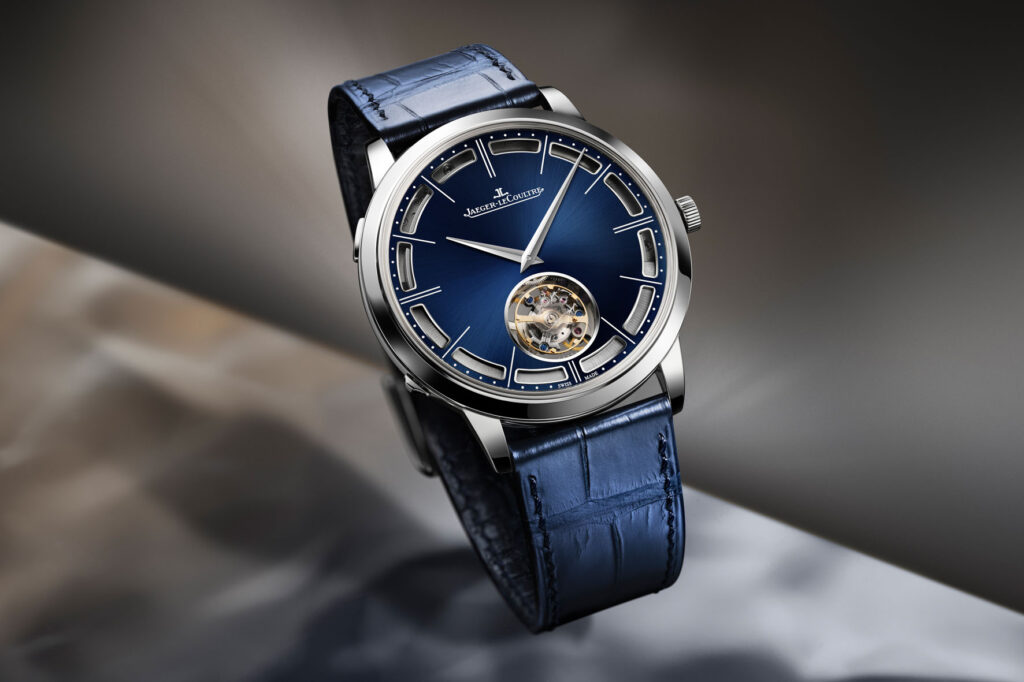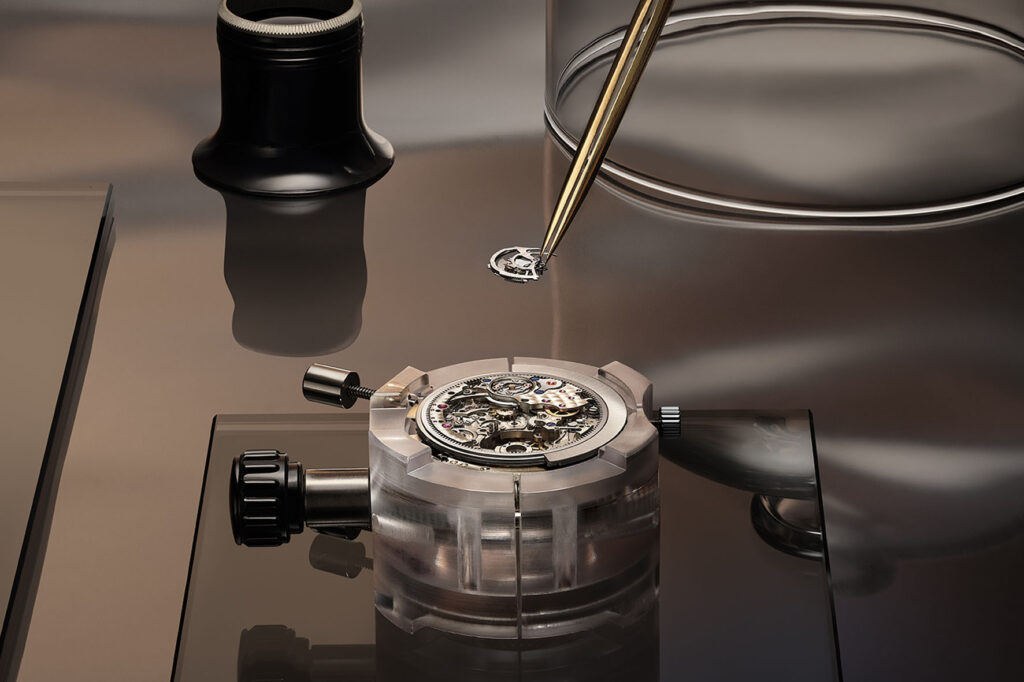Jaeger-LeCoultre: Master Hybris Mechanica Calibre 362
27 November 2024Marking a decade since the Master Hybris Mechanica Calibre 362 was first introduced, Jaeger- LeCoultre presents a new interpretation of the ultra-thin minute repeater in a five-piece limited edition with a deep midnight-blue sunrayed dial in an 18k white gold case. It was, at the time of its launch, one of the world’s thinnest minute repeater wristwatch with a tourbillon in production, and it is still today Jaeger-LeCoultre’s thinnest minute repeater in collection, at 7.8 mm – all the more rare for being a high-complication movement with automatic winding. The calibre itself, comprising 566 parts is only 4.7 mm thick.

THE 8 PATENTS OF THE MASTER HYBRIS MECHANICA
The Master Hybris Mechanica Calibre 362 represents eight separate patents, two for previous inventions related to chiming mechanisms – crystal gongs (2005) and trebuchet hammers (2009) – and six for inventions developed specifically for this timepiece:
- Flying balance wheel
- Flying balance wheel in a flying tourbillon
- S-shaped hairspring
- Fixed winding stroke on the minute repeater
- Retractable push-button on the minute repeater
- Silent-timelapse reduction on the minute repeater
Achieving the goal of thinness required a complete re-think of the regulating organ and for Calibre 362, Jaeger-LeCoultre developed and patented a new form of flying tourbillon – one that is fitted with a flying balance wheel. This structure also required a re-think of the balance spring and the result is the patented S-shaped hairspring, which is fixed above the balance wheel, in full view of the observer. As well as reducing the overall thickness of the calibre, uncaging the tourbillon allowed for a larger balance wheel, which, with the oscillation rate of 21,600vph creates greater stability and thus further enhances the precision of the timekeeping. Not only a technical feat, the design of the flying tourbillon brings an aesthetic benefit: with no bridge or upper cage, there is no visual impediment to the display of its mesmerising oscillations.

To provide the convenience of automatic winding to the wearer, Calibre 362 was conceived as a self- winding movement. However, this required Jaeger-LeCoultre’s watchmakers to re-think the design of the winding rotor, which normally sits on top of the movement, adding thickness. Their solution was to develop a peripheral rotor. Encircling the calibre, it has a section in Platinum 950/1000 to create the necessary weight and is mounted on ceramic ball bearings to ensure that it swings freely, with minimal friction. This positioning of the rotor also has aesthetic benefits: it can be observed through the slots around the dial as it rotates, adding visual intrigue, while the view of the movement through the transparent sapphire case-back is completely unimpeded.

Crystal gongs and trebuchet hammers enhance the quality of the chime. Being attached directly to the glass of the watch, the gongs turn the sapphire crystal into a resonator, exploiting the superior acoustic qualities of that material. The articulated hammers recoup the great majority of the energy lost in traditional minute repeater construction, thus enabling a chime of unprecedented strength.
The watchmakers supplemented these elements with a new invention: silent-timelapse reduction. Integrated into the strike train, this reduces the pause between the chiming of the hours and minutes when there are no quarter-hours to be struck. In a traditional minute repeater, when there are no quarters to be struck, there is a lengthy pause between the chimes for the hours and the minutes; this new feature diminishes the silence and chimes the minutes rapidly after the hour strikes.

Turning their attention to the aesthetics of the watch, Jaeger-LeCoultre’s engineers developed and patented a new mechanism to activate the minute repeater: a discreet unlocking button at 8 o’clock on the case side and a retractable push-button at 10 o’clock. When the locking button is moved, the pusher pops out; when the pusher is pressed in, the striking mechanism is activated and the pusher remains recessed until activated again, thus preserving the pure lines of the round case. This repeater activating system also delivers a performance benefit, enabling the case to be made water-resistant more easily. Water-resistant minute repeaters are rare indeed, and the Master Hybris Mechanica Calibre 362 is water-resistant to 3 bar.
ELEGANTLY COMPLICATED
At 41mm diameter and just 7.8 mm thick, the case of the Master Hybris Mechanica Calibre 362 was inspired by the elegance of the Maison’s early 20th-century ultra-thin pocket-watches – in particular the 1907 couteau (knife) pocket watch. The Manufacture chose white gold because of the metal’s superior acoustic qualities and, in the new interpretation of the timepiece, the midnight blue sunrayed dial contrasts dramatically with the hand- polished bezel, sides and tapering lugs. Against the deep blue background, the simplicity of the dial indications also pays subtle tribute to Jaeger-LeCoultre’s historic pocket watches: elongated Dauphine hands, hours marked with simple batons and minutes marked by white dots.

Haute Horlogerie finishes abound, including Côtes de Genève on certain bridges, and hand-bevelling, with the characteristically sharp internal angles bearing testimony to the Métiers RaresTM atelier’s craftsmen’s skill and attention to detail. Further evidence of that attention to detail is evident on the dial side, where sections of the peripheral oscillating weight have been delicately snailed.
